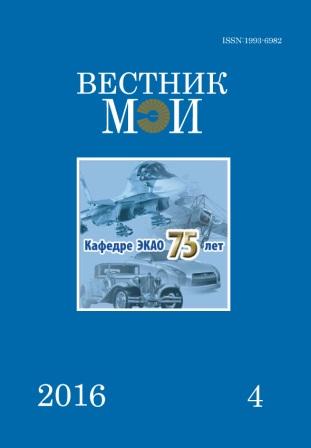Проектирование электрических машин с поперечным магнитным потоком
Аннотация
Для новых областей использования электрических машин: автомобиля с гибридной энергоустановкой, прямого электропривода судового винта, ветрогенератора с безредукторным приводом электрогенератора, — разработана новая конструкция многополюсной электрической машины с постоянными магнитами, отличающаяся большим моментом при низких скоростях вращения иполучившая в литературе два названия: машины с поперечным магнитным потоком или машины с коммутируемым магнитным потоком. Она может использоваться в двигательном и генераторном режимах, регулирующихся силовыми полупроводниковыми коммутаторами. Приведены две типовые схемы магнитной цепи, отличающиеся числом постоянных магнитов на полюсе. В большинстве случаев используются кольцевые статорные обмотки. В качестве базового размера, определяющего размеры машины и ее обмотки, была принята длина части полюса статора, взаимодействующая через воздушный зазор с постоянными магнитами, определяющая осевую длину машины и поперечные сечения магнитопровода. Основная расчетная формула для базового размера получена в виде корня четвертой степени из выражения, содержащего момент машины. Все остальные размеры магнитопровода и обмоток через постоянные коэффициенты связаны с базовым размером. Представлена модель машины в программе Matlab, работающая в качестве ветрогенератора с переменной электрической нагрузкой. При коммутации нагрузки в сторону увеличения и уменьшения фиксировали изменение скорости вращения, момента и мощности. Для мощности 75 к Вт указаны характеристики данной машины и ранее известных типов машин и показано, что настоящая машина имеет минимальные массу, объем и максимальный КПД при близких скоростях вращения 570 — 610 об/мин. Даны рекомендации по ее использованию в качестве мотор-колеса для гибридной транспортной энергоустановки.
Литература
2. Cosic A. Analysis of a novel transverse flux machine with a tubular cross-section for free piston energy converter application // Doctoral thesis. Stockholm (Sweden): KTH School of Electrical Eng., 2010.
3. Pat. № 5051641 USA. Transversal flow machine in accumulator arrangement, 1991.
4. Pat. № 6952068 USA. Fabricated components of transverse flux electric motors, 2005.
5. Persson M., Jansson P., Jack A.G., Mecrow B.C. Soft magnetic composite materials — use for electrical machines // Proc. IEEE Conf. Electr. Machines Drives. Durham (UK), 1995. P. 242 — 246.
6. Löwenstein L. Kurbelwellen-Starter-Generatoren auf der Basis von Reluktanzmaschinen // Thesis RWTH Aachen. Aachen, 2003.
7. Henneberger G., Bork M. Development of a transverse flux traction motor in a direct drive system// Proc. Intern. Conf. Electrical Machines. Helsinki (Finland), 2000. P. 1457 — 1460.
8. Wan Z., Ahmed A., Husain I., Muljadi E. A novel transverse flux machine for vehicle // Traction Appl., 2015. [Электрон. ресурс]. http://www.nrel.gov/docs/fy15osti/63661.pdf (дата обращения 11.08.16).
9. Popan A.D., Viorel I.A., Blissenbach R. A passive rotor transverse flux motor, 2002. [Электрон. ресурс]. http://szabol0.tripod.com/WorkshopVRM/Workshop_VRM_6.pdf (дата обращения 20.08.16).
10. Ustkoyuncu N., Ramu K. A performance comparison of conventional and transverse ux linear switched reluctance motors, 2015. [Электрон. ресурс]. http://journals.tubitak.gov.tr/elektrik/issues/elk-15-23-4/elk-23-4-4-1305-214.pdf (дата обращения 22.08.16).
11. Babazadeh A., Karimi H.R. Adaptive output tracking of transverse flux machines using neuro-fuzzy approach, 2006. [Электрон. ресурс]. http://www2.tku.edu.tw/~tkjse/9-2/9-2-5.pdf (дата обращения 15.08.16).
12. Ping Zheng e. a. Analysis and design of a transverse-flux dual rotor machine for power-split hybrid electric vehicle applications, 2013. [Электрон. ресурс].http://www.mdpi.com/ (дата обращения 11.08.16).
13. Huang S., Luo J., Lipo T.A. Analysis and evaluation of the transverse flux circumferential current machine, 1997. [Электрон. ресурс]. http://lipo.ece.wisc.edu/1997pub/97-30.pdf (дата обращения 01.08.16).
14. Ji-Young Lee e. a. Characteristic analysis of a permanent magnet transverse flux linear motor with spiral core, 2013. [Электрон. ресурс]. http://www.koreascience.or.kr/ (дата обращения 11.08.16).
15. Jiyoung Lee e. a. Comparison of transverse flux rotary machines with different stator core topologies, 2014. [Электрон. ресурс]. http://www.academia.edu/3795193/A_Comparison_of_Radial_and_Axial_Flux_Structures_in_Electrical_Machines (дата обращения 07.08.16).
16. Velicu S. e. a. Computer aided design (cad) of linear transverse flux motors used in drive of the machine tools, 2010. [Электрон. ресурс]. http://www.eng.upt.ro/auif/Lucrari_PDF2_2010/Velicu.pdf (дата обращения 03.08.16).
17. Dobzhanskyi O. Study on permanent magnet transverse flux machine [Электрон. ресурс].http://ieeexplore.ieee.org/document/7219443/ (дата обращения 05.08.16).




